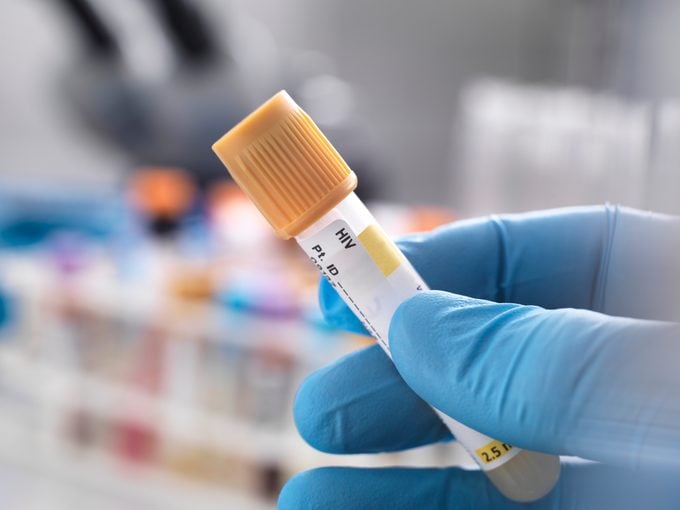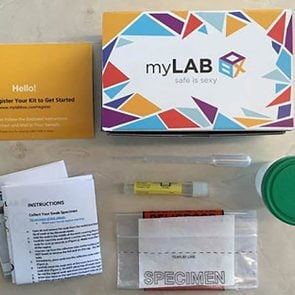Do You Need an STD Testing Subscription?
Updated: Mar. 22, 2021
Current is a new STD test subscription service that offers at-home tests for infections like chlamydia and gonorrhea. Who is it for—and is it reliable?
Our editors and experts handpick every product we feature. We may earn a commission from your purchases.
STD testing in your mailbox
You can get a subscription for everything from fitness clothes to vegan meals to hair dye. You might be surprised to know you can also subscribe to monthly sexually transmitted diseases (STD) testing. For the price of a Netflix subscription, you can get an STD test delivered to your door (in an unmarked package). You take the test, send it back, and get your results just a few days later.
Here’s what you need to know about the new STD testing subscription and whether it can be as good as an in-person doctor’s visit. (And check out these facts about STDs that could save your life.)

How at-home STD testing works
Current is a new STD test subscription service from EverlyWell, a company that provides at-home tests for many medical conditions. Current is $14.99 a month and offers tests for chlamydia and gonorrhea, syphilis, hepatitis C, trichomoniasis, and human immunodeficiency virus (HIV). Each month you choose one test. If you want to cover all your health bases, you can order the seven-panel test that includes all of the previously listed STDs plus herpes type 2, for the one-time cost of $149. (If you want to subscribe to the seven-panel test, the cost is $111 a month, but there are quarterly and semi-annual options, as well.)
The test arrives in a discreet package and comes with all the instructions and supplies you need. Depending on which test you order, you’ll receive swabs for bodily fluids, a collection cup for urine, and/or an automatic finger-stick lancet for blood. You take your own sample, put it in the pre-paid return box, and drop it in the mail. You can track the progress online once you’ve shipped your test. (P.S. This isn’t the only option; here’s an at-home STD testing we tried.)
Several days later, you get your results via your choice of text or email. If your results are positive, you’ll also receive a call from a doctor who will discuss treatment options with you. In some cases, the doctor can prescribe antibiotics or other medication over the phone. You are always encouraged to follow up with your own health care provider.
Who can this STD testing subscription benefit?
The test was first designed for people participating in high-risk sexual behavior and who may not have access to regular STD testing, says Christina Song, director of communications for Everlywell. However, since the pandemic started, many people have been looking for at-home options for all kinds of medical care, including sexual health. (Going virtual? Here’s how to get the most out of your telemedicine appointment.)
STDs are the fastest-growing category of infectious diseases, with the Centers for Disease Control and Prevention (CDC) reporting 20 million new STDs every year. But during the pandemic, testing dropped dramatically, likely due to people not having access to clinics and other testing facilities, according to the CDC. (Here’s how coronavirus may affect libido.)
“Nobody thinks it’s because people stopped having unprotected sex; people will find a way, even in quarantine,” says Charlene Brown, MD a preventative medicine physician specializing in public health, a former medical officer for the U.S. Food and Drug Administration in the Division of Antivirals, and an adjunct assistant professor at the Emory School of Medicine. “The problem is that people who don’t know they have an STD are far more likely to spread it to others, particularly since some infections can lay dormant or may not show any symptoms at all.”
Plus, STDs can lead to serious health complications if left untreated. “Most STDs are curable, which is why accessible, affordable testing is so important,” she says, adding that an at-home kit takes away the stigma or embarrassment some people feel getting STD tests.
“I always recommend getting tested for STDs yearly, in between partners, or if you’ve had unprotected intercourse,” says Sherry A. Ross, MD, ob-gyn, and women’s health expert in Santa Monica, California and author of She-ology: The Definitive Guide to Women’s Intimate Health. “I love the idea of frequently performed STI [sexually transmitted infections] testing and being able to do it in the comfort of your home, but I do see a few problems with this style of testing.”
Is at-home STD testing accurate?
The at-home STD tests are processed by the same laboratories using the same processes that doctors’ offices use and, according to data provided by the company, are just as accurate. Every lab is CLIA (Clinical Laboratory Improvement Amendments) certified and that requires regular checks to make sure the tests meet accuracy standards.
The one problem is that taking your own sample may mean a higher risk of getting a contaminated or unusable sample, Dr. Brown says. The kit provides instructions on how to get a clean sample, but things happen and most people aren’t trained in medical specimen collecting.
Dr. Ross says she is concerned that this type of test may miss some STDs or other serious health conditions that your doctor would catch during an in-person or telehealth appointment. STDs have an incubation period, typically seven to 14 days, and you will get a false negative if you test during that period. A false negative is when you have an STD but get a negative result in a test.
You may also have selected a test for a different STD than the one you have or you may have one of the STDs that the Current kits don’t test for. For instance, she points out that there isn’t a test for human papillomavirus (HPV), a very common STD that requires a sample taken from your cervix—something most women wouldn’t even want to think about attempting at home.

Online versus in-office STD testing
Dr. Ross points out that your doctor can talk to you about your specific sexual history and risks, including things that can’t be tested for with a kit—like abuse and addiction. Doctors also have access to far more tests than are offered in the kits. All of this will give you a more accurate overall picture of your sexual health rather than the “snapshot” provided by Current, she says.
You should not use negative results from one STD test as a “clean bill” of sexual health, giving you permission to have unprotected sex, Dr. Brown says. Following safe sex practices protects you from a lot more than the six STDs, she adds. (Make sure you know about stealthing—the sex trend that could give you an STD, or worse.) “This test kit should be used as part of a larger plan for good sexual health, not as a substitute for it,” Dr. Brown says.
The takeaway
Even after the pandemic ends, Dr. Brown still sees a need for easier access to STD testing. “You’re always going to have a subset of people who can’t get a test because of their location, family, lack of resources, or religion, or who won’t get a test due to embarrassment or fear,” she says.
One group that could benefit are people who don’t have health insurance and are therefore financially unable to see a doctor, Dr. Brown says. This often encompasses groups at very high risk for STDs, like sex workers. It could also help people who have risky and/or frequent sex, she says.
For everyone else, however, this is more of a nice thing to have, rather than a need, Dr. Ross says. Getting frequent testing can help put your mind at ease, particularly right after a known exposure.
“This could be helpful for monitoring your health in between doctor’s visits or if going to the doctor is physically impossible,” Dr. Ross says. “But I would make this the exception, not the rule. Nothing replaces a trip to the doctor, including a physical inspection of the genitals and a face-to-face conversation, which is irreplaceable.”

















